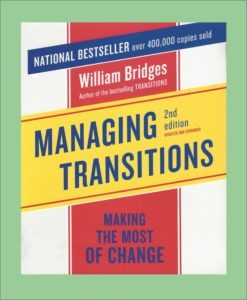Bridge Explains Transitions

William Bridge. 2003. Managing Transitions: Making the Most of Change. Cambridge: Da Capo Press.
Review by Stephen W. Hiemstra
Early in my government career I noticed that new political appointees did not immediately affect the course of my work. Rather, their views typically took a year or more to filter down through the bureaucracy into my job description. During this period, objective research could be published without reference to the positions they expressed on Capitol Hill. After that, the freedom of response disappeared.
Introduction
William Bridges (www.WMBridges.com) would describe my observation on research in government service as a type of transition. Bridges describes a transition as a 3-stage, psychological process in an organizational setting. These stages are:
Letting go of the old ways and the old identity people had;
Going through an in-between time when the old is gone, but the new isn’t fully operational; and
Coming out of the transition and making a new beginning (3-5)
He calls the first stage an “ending”, the second “the neutral zone”, and the last a “new beginning” (5). While Bridges focuses on organizational behavior, like my story about government research, the idea of a transition nicely describes individual experiences, like a hospital visit, going to college, and a host of other stressful experiences in life.
Bridge’s first stage—an ending—is unexpected. We expect the first stage to be a discussion of how leadership lays out new objectives. Bridge’s observes: Before can begin something new, you have to end what used to be (23). Endings involve losses which need to be recognized, assessed, and celebrated before we can move on (25-27). All losses need to be grieved and grieving takes time (28).
At one point, I remember a manager informing me that a very successful project that I had been doing for about 7 years was over and I needed to start something new—it would have been easier to have been run over by a truck. The sense of loss was real; the pain was immediate; the project had defined my identity for so long that I could not imagine not doing it.
Bridges suggests both making a list of losses and compensating the losers so that they have less incentive to sabotage the proposed change (30-31). In one office where I worked, for example, displaced managers were given dream assignments in Europe as compensation for trading a staff for a desk.
Bridge’s second stage—the neutral zone—is both a stressful period and a time of innovation. Supervisors become impatient; staff develops anxiety attacks; signals are mixed and confusing; new lines of communication open up (40-42). At one point, my career was dead in the water as we entered a period of reorganization; after I volunteered to help out the reorganization team, things turned around. Later, I was offered a better position in other unit and ended up with a promotion.
Bridges observed that it was during the 40 years in the desert that the Nation of Israel was born—it took Moses maybe 40 days to get the people of Israel out of Egypt, but it took him 40 years to get Egypt out of the people (43).
The neutral zone is not a highly productive period, but it is a created time. It is a time to build infrastructure—new roles, new policies and procedures, new teams (45-46). After being admitted to college, you have to take an awful lot of classes before you complete your degree and graduate. College classes are a great symbol of the neutral zone.
Bridge’s third stage—the new beginning—is also a new identity. This is when the new organizational charts go up on the wall (57). Bridges talks about the marathon effect where thousands of runners are involved. Front runners take off like rabbits; middle runners run more slowly behind; and the weekend runners bring up the rear so far behind that they cannot even hear the starting gun (65). The point is that not everyone in an organization transitions at the same speed.
Bridges offers 4 rules for transitioning:
Offer a consistent message;
Celebrate milestones marking small successes;
Develop symbols of the new identity; and
Take time to celebrate arriving at the new destination (69-72).
Following Skakespeare, Bridges describes organizational life in 7 stages:
Dreaming the dream;
Launching the venture;
Getting organized;
Making it;
Institutionalizing;
Ossifying; and
Dying (77-82).
The hope, of course, is that leadership can anticipate these stages and reinvent the organization repeatedly to avoid the later stages.
Assessment
Bridge’s idea of a transition has been enormously helpful throughout my career both as an economist and a pastor. Understanding where an organization is during a transition guides how to navigate in one’s career and how not to be sidelined. The same can be side for individuals caught up in the important transitions of life—growing up, going to school, marriage, growing older, and so on. Managing Transitions is a book to read and apply—over and over.
Bridge Explains Transitions
Also see:
Nouwen: Make Space for Self, Others, and God
Vanhoozer: How Do We Understand the Bible? Part 1
Books, Films, and Ministry
Other ways to engage online:
Author site: http://www.StephenWHiemstra.net
Publisher site: http://www.T2Pneuma.com
Newsletter: https://bit.ly/TestWater_2020
The post Bridge Explains Transitions appeared first on T2Pneuma.net.



